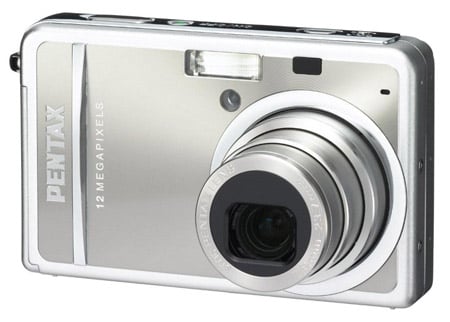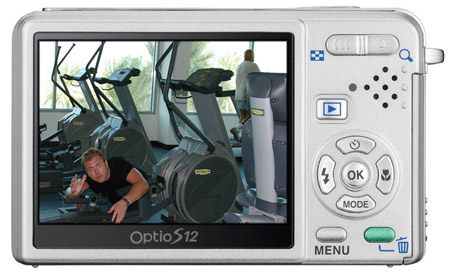Original URL: https://www.theregister.com/2008/06/12/review_pentax_optio_s12/
Pentax Optio S12 compact camera
Compelling upgrade?
Posted in Personal Tech, 12th June 2008 11:02 GMT
Review Thankfully, digital camera manufacturers have stopped stuffing ever more megapixels into their compact cameras. That's good because performance suffers and, for most folk, eight megapixels are fine.
Manufacturers have instead focused on introducing useful features like face detection and image stabilisation. So why has Pentax launched the 12-megapixel Optio S12? A good question, and one suspects that it’s simply a way of distinguishing the camera from its predecessor, the Optio S10 - no prizes for guessing how many pixels this little model offered - which we looked at in February.

Pentax's Optio S12: almost identical to the S10
Cosmetically, there’s not a lot of difference, with both models finished in a two-tone silver. They’re also the same size and weight – 87 x 54 x 21mm and 130g. The Optio S12 isn’t quite a case of “the same chocolates in a different box”, but it comes darned close. Oh, and you’ll pay an additional 50 quid for the extra megapixels.
At the front, there's the usual lens and flash arrangement, and on top is a display button, power key - which glows green when the camera is switched on - and shutter button. At the back is a nice, large 2.5in LCD screen, zoom buttons, playback button, and four-way controller for flash, macro, drive mode and program mode select. Tucked below this is a menu button and a green mode button, which returns the camera to the default settings. At the side is a flap for the battery and SD or SDHC card.
In addition to a 12-megapixel, 1/1.7in CCD, you get a 3x, 7.9-23.7mm optical zoom, equivalent to a 38-114mm, 35mm lens, which means you don’t get a great wide angle performance on this camera. Other features include face detection and pentax’s cut-down version of an image-stabilisation system, which the company calls "Digital Shake Reduction" - it basically boosts the ISO to 3200.
These features work in all shooting modes, which wasn't the case with the S10. Shutter speed ranges from 1/2000 to 4 seconds, and the selectable ISO range is from 80-1600. The Optio S12 will also shoot Divx movies in 640 x 480 (VGA) and 320 x 240 (QVGA) at 30f/s. There’s also a handy 21MB of internal memory.
If you used a Pentax camera before, this camera will feel like an old friend, and if you’re not familiar with the brand, it will soon feel like a new friend because it’s very easy to get to grips with. Switch it on, and the Optio S12 is shooting in next to no time. Switching between the different modes is a doddle, and Pentax uses a mix of icons and text descriptions to guide you through the various options.

Aimed at those who prefer point-and-shoot
The tabbed menu lets you make changes to the camera mode, such as the image quality, and the camera settings - for example, date and sound. Anyone pressing the wrong button can simply use the green button to get back to the original camera settings. There’s really not a lot of scope for a great deal of creativity with this camera in terms of manual control, but then again, this is very much aimed at the point-and-shoot brigade. In that respect, the Optio S12 more than delivers the goods.
The large LCD screen gives you lots of information if you want it, but it was very difficult to see things when shooting in bright sunlight. Yes, we know that all LCD screens suffer from this problem, but the Optio S12's screen seemed worse than others. The Optio S10 had the same problem. It would have been handy if Pentax had provided an optical viewfinder as well.
In terms of performance, the Optio S12 delivers pretty good pictures, but we have to confess that we really didn’t see any improvement over the S10, even when images were printed out. The downside of having a 12-megapixel camera is that the files are larger and so it takes longer to write data to the memory card.
Sample shots
Click for full-size images

The S12 offers good image quality, but we doubt if many will notice a significant difference between this and a ten- or eight-megapixel offering

We didn’t see any noticeable difference when using the skin-tone setting - switched off on the left image

Not all food-mode program settings work, but we thought the S12’s did make our fish, chips and mushy peas look rather more appealing

Sports mode is designed to capture fast moving objects, we didn’t think the setting on this camera made much impact
The Optio S12 is no slouch, but you do notice the lag when shooting a succession of images. Likewise, the autofocus system wasn’t the sharpest knife in the box, and in many of our shots, took a while to settle down, especially at the telephoto end.
As usual, we tried out a number of camera modes. Natural skin tone mode is supposed to give your subjects a... er... more natural skin tone, but we didn’t see any noticeable difference whatever the complexion. Food mode, however, did make our plate of fish and chips looks more appetising. Sports mode, designed for fast moving objects, didn’t seem that much better than when shooting in auto mode. That said, we did like the picture quality offered by this camera, which have good resolution and colour.
Verdict
Some new products are a giant leap forward, but in the case of the Optio S12, it’s more a case of a tiny step forward. As with its predecessor, you’re getting a camera that will deliver a good performance almost every time you use it. If you already own the Optio S10, you wouldn’t want to rush to replace it with this model. Indeed, faced with a choice between the two, we’d opt for the S10 and use to £50 difference to buy ourselves a little treat.